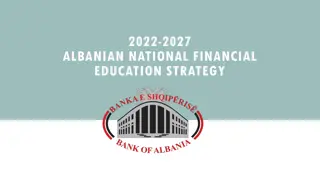Financial Forecast and Challenges for AHS
AHS operates with a Net Negative Balance (NNB) structured like a loan, facing challenges with timing and magnitude of supplemental payments. Strategic planning and efficiency improvements are crucial for financial viability. The forecast shows expense inflation outpacing revenue growth, necessitating strategic planning and technology investment. The Distressed Hospital Loan Program aims to assist financially challenged hospitals in California.
Download Presentation

Please find below an Image/Link to download the presentation.
The content on the website is provided AS IS for your information and personal use only. It may not be sold, licensed, or shared on other websites without obtaining consent from the author.If you encounter any issues during the download, it is possible that the publisher has removed the file from their server.
You are allowed to download the files provided on this website for personal or commercial use, subject to the condition that they are used lawfully. All files are the property of their respective owners.
The content on the website is provided AS IS for your information and personal use only. It may not be sold, licensed, or shared on other websites without obtaining consent from the author.
E N D
Presentation Transcript
NNB Forecast through FY27 Board of Trustees Retreat May 3, 2024
Net Negative Balance (NNB) Forecast AHS operates on a line of credit with Alameda County under the Permanent agreement. The NNB is currently structured similar to a loan with annual repayment of principal ($5M) which decreases the amount available to draw at the end of each fiscal year. AHS is allowed flexibility to draw $50M during the fiscal year but must hit the NNB on June 30 of each year. Current agreement effective 3/24/16 through 2034. Opens every 5-years or as needed. AHS operations have grown over the years to have an operating budget of $1.4B. The timing and magnitude of supplemental payments requires a line of credit since most payments occur at the end of the program period. Supplemental funding represents 35% of revenues and timing of receipt is not always predictable. AHS does not have sufficient assets to self-finance. Strategic Planning and the Financial Forecast AHS engaged Huron to create a Strategic Plan which reflected shortfalls in forecasted years. Continuous improvement and efficiency are needed to stay viable. Government funding tied to metrics which require providers of services to show value. 2
NNB Projection through FY27 FY25 forecast based on FY24 Q3 expenditures and latest supplemental timing. FY26 and FY27 assumptions: Patient and Measure A receipts increase 2.0% each year Expense increase 2.0% each year Timing of supplemental program payments clustering in Spring. AHS will need to coordinate with County for inter-year threshold increase. 4
NNB Projection through FY27, continued Expense inflation has outpaced revenue growth. FY23 includes Capital Cost to County $34M. Strategic planning, technology and gained efficiently needed to operate without deficits. 5
Distressed Hospital Loan Program AHS is not alone. Many hospitals are experiencing deficits which threaten the viability of the California Healthcare Delivery System. The Distressed Hospital Loan Program was developed by Department of Health Care Access and Information (HCAI) to assist financially distressed hospitals to implement turnaround strategies and regain financial viability. Awarded $300M in no-interest working capital loans to 17 California facilities. To prevent hospital closures or facilitate reopening of hospitals. Non-profit hospitals, publicly-owned hospitals and hospitals within integrated health care systems are eligible. Application period closed on July 31, 2023 for first round funding. Loan features: o Interest-free working capital loans. o Repayable over 72-months with an initial 18-month grace period. Program administer by HCAI and California Health Facilities Financing Authority. o Loans secured by Medi-Cal checkwrite payments. o Hospitals must submit quarterly financial data to HCAI for monitoring. o Program ends December 31, 2031. 7























